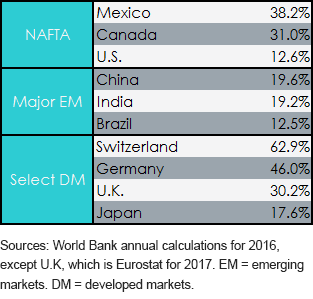By Jeff Weniger, CFA, WisdomTree Investments
Special to the Financial Independence Hub
The 24-year-old North American Free Trade Agreement (NAFTA) has never been this close to death, but a resolution could be behind the storm clouds.
Souring trade relations with the U.S. are a shame, because Canada got caught in the wrong place at the wrong time. Consider figure 1. President Donald Trump wants to make a dent in the US$388 billion annual trade deficit with China and, to a lesser extent, the yawning gaps with Mexico, Germany and Japan. But to show strength to them economically and North Korea militarily, he believes he has to treat even friendly actors such as Japan and Canada like hostile players. That became apparent when the U.S. administration imposed global steel and aluminum tariffs, and Canada wasn’t exempted.
Figure 1: Monthly U.S. Trade Deficit/Surplus (USD in Millions)
Talks are starting to get personal, with U.S. President Donald Trump accusing Prime Minister Justin Trudeau of making false statements at a June news conference after G7 leaders met amicably. The Canadian leader then got relatively tough, responding that “Canadians … will not be pushed around.”
With the world’s two best friends in a lovers’ quarrel, the US$13 billion annual U.S.-Canadian trade gap, a rounding error, is somehow a political issue. It could have been resolved over golf.
But not all is lost. Ottawa would be wise to consider — if it is legal — scrapping NAFTA for a bilateral trade agreement with Washington.
Canada ill-advised to sit at table with Mexico
That’s because Canada is ill-advised to sit at the table with Mexico to try to strongarm the U.S. Not now, in 2018, given Mexico’s own specific troubles. Frankly, Mexico’s negotiating calculus is much weaker than Canada’s. The country went to the polls July 1, and leftist Andrés Manuel López Obrador (AMLO) won. He won’t help Canada one bit because it isn’t politically palpable for him to shoot for a quick resolution. Hostility to the U.S. — or at least standing ground against Washington — has been a political winner for the Latin American “pink tide”1 for years. Playing the tough-talk game with Trump will be one of AMLO’s key rallying cries, and it can only cripple NAFTA.
Also, Mexico stands to lose a lot more than Canada for two reasons: first, its U.S. trade gap is more than five times larger than Canada’s gap with the U.S., even though Mexico’s economy is 32% smaller than Canada’s.2 Additionally, elimination of NAFTA could cost Mexico more lost jobs than the U.S., even though the latter has three times as many people.3
Second — and more importantly — the American public is much more upset about wage arbitrage with Mexico than it is with Canada. Plant workers at General Motors don’t come home from a long day at the plant and lament that Magna is engaging in labor cost arbitrage because there is no labor cost arbitrage “up there.” But Mexican and Chinese companies? Every day.
Nevertheless, the truth is that Ottawa’s negotiating hand is still pretty weak because the U.S. relies so little on exports as a percentage of gross domestic product (GDP) (figure 2). Yes, it feels like everything in our homes is made in China; it is, after all, the world’s largest exporter. But then again, China is also the second-largest economy. The largely unrealized reality is that China’s exports are actually small in context. In contrast, Mexico and Canada live and die by exports. But Canada may be able to get itself out of the corner with a couple of “concessions.”
Figure 2: Exports as Percentage of GDP
Giving Trump a Win
There are two “concessions” Ottawa could propose in bilateral negotiations that could give Trump the illusion of victory. One is the sunset clause. Trump has been adamant about a five-year sunset on NAFTA. Ottawa is steadfastly against it. But logic indicates that a 10- or 20-year sunset on a bilateral agreement is a decent idea. Politically, it would settle all right with Main Street Canada; most people probably don’t want to find themselves bound to an aging 2018 document come 2028 or 2038.
Beyond the sunset clause, Trump has been pushing Canada on dairy tariffs, introducing the American public to the northern nation’s 270% tariff, a protective measure that causes everyday Canadians to pay exorbitant prices for milk and cheese. Those two — the sunset clause and dairy tariffs — could maybe get an agreement done, because Canada would be making two concessions while the U.S. would give up nothing. Remember, the game was never about Canada; it was about showing China and North Korea that the U.S. is serious about “America First.” Trump would have a “win” against Ottawa to flaunt at Beijing and Pyongyang.
Replace NAFTA with CUSFTA
Canada is going to lose in these negotiations, but if it plays its hand correctly, it may not hurt the country in aggregate much at all. NAFTA’s replacement — call it the Canada-U.S. Free Trade Agreement or CUSFTA — would remove the cloud of cross-border uncertainty, maybe soon. Then Canadians can get on with their lives knowing that their southern business interests are largely uninterrupted. The Chinese, Americans, Mexicans, Germans and the rest would continue to punch each other in the faces based on their own geopolitical and economic circumstances, while Ottawa would head into 2019 with a known quantity south of the border.
1The term that describes the leftward shift in Latin American politics over the last couple of decades. Examples include the generational success of the Workers’ Party in Brazil (Lula and Rousseff) before Temer, years of power by Evo Morales in Bolivia and the Chávez-Maduro dynasty that is currently crumbling in Venezuela.
2Source: World Bank, as of 2016.
3Source: World Bank for Mexico, 2016; U.S. Census Bureau for U.S., 2017.
 Jeff Weniger, CFA serves as Asset Allocation Strategist at WisdomTree. Jeff has a background in fundamental, economic and behavioral analysis for strategic and tactical asset allocation. Prior to joining WisdomTree, he was Director, Senior Strategist with BMO from 2006 to 2017, serving on the Asset Allocation Committee and co-managing the firm’s ETF model portfolios. Jeff has a B.S. in Finance from the University of Florida and an MBA from Notre Dame. He is a CFA charter holder and an active member of the CFA Society of Chicago and the CFA Institute since 2006. He has appeared in various financial publications such as Barron’s and the Wall Street Journal and makes regular appearances on Canada’s Business News Network (BNN) and Wharton Business Radio.
Jeff Weniger, CFA serves as Asset Allocation Strategist at WisdomTree. Jeff has a background in fundamental, economic and behavioral analysis for strategic and tactical asset allocation. Prior to joining WisdomTree, he was Director, Senior Strategist with BMO from 2006 to 2017, serving on the Asset Allocation Committee and co-managing the firm’s ETF model portfolios. Jeff has a B.S. in Finance from the University of Florida and an MBA from Notre Dame. He is a CFA charter holder and an active member of the CFA Society of Chicago and the CFA Institute since 2006. He has appeared in various financial publications such as Barron’s and the Wall Street Journal and makes regular appearances on Canada’s Business News Network (BNN) and Wharton Business Radio.
Important Risks Related to this Article




